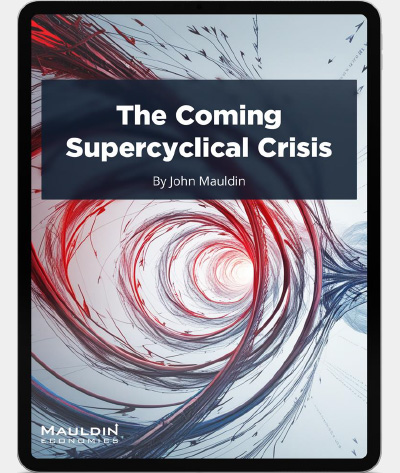
Big Debt Cycles, Part 2
-
 John Mauldin
John Mauldin
- |
- October 10, 2025
- |
- Comments
- |
- View PDF
Today we continue reviewing Ray Dalio’s latest book, How Countries Go Broke. If, like me, you fear that you may soon live in such a country, Ray’s work reads like a guidebook to the future. But in fact, this future is just the latest iteration of a well-known debt cycle, one that is almost natural in its regularity.
Strike that. The debt cycle is natural because it springs from human nature. Let’s look again at Ray’s description, which I quoted last week.
“…When someone borrows money… the borrower-debtor can spend more money than they have in earnings and savings over the near term.
“But over the long term, this requires them to pay back the principal plus interest, and when they have to pay it back, it requires them to spend less money than they have. This dynamic is why the credit/spending/debt-paying-back dynamic is inherently cyclical.”
We keep having debt crises because we, as a species, keep making the same mistakes.
Yes, we learn from those mistakes. We always vow not to make them again. But later generations take no such vows, so flawed human nature soon reasserts itself. This may be why the Big Debt Cycle, as Ray describes it, typically lasts around 80 years, the length of a human lifetime. (Funny how that also follows The Fourth Turning and George Friedman’s “institutional crisis” cycle.)
Followers of libertarian/Austrian economic ideas might object to this, saying boom-bust cycles are purely the result of government intervention. We’ll have that debate another time. For now, I think we can all agree that governments do intervene in often unhelpful ways.
In recent centuries, governments did this mostly by creating central banks. These institutions are, unfortunately, also subject to human folly. They often fail in their missions, but Ray Dalio describes how they can (at least in theory) help minimize the harm these cycles produce.
Today we’ll go through the steps central banks typically follow through the debt cycle. Then we’ll contrast them with what central banks could do that might actually work.
Well-Trod Path
Last week in Part 1 of this series, I described the five stages of Dalio’s Big Debt Cycle. I dubbed them the “Stages of Grief.” Briefly, the cycle goes from a state with “sound money” to a “debt bubble,” then the “bubble” pops, followed by a giant “deleveraging,” and finally reaches a “new equilibrium” from which the next cycle begins.
As this process unfolds, central banks keep adapting their monetary policies as they try to keep the good times rolling. They can do this for a surprisingly long time, too, which may actually aggravate the situation by letting excesses grow larger (cf. Minsky). But in any case, the path is well-trod. The details vary but the stages are remarkably consistent.
I’ll describe these phases using recent US history as an analog. Keep in mind, though, that Dalio shows how the process has been similar in other times and places.
Phase 1: A Linked (i.e., Hard) Monetary System
Dalio says this kind of monetary system prevailed from 1945 to 1971. You may recognize that period as the old “Bretton Woods” era. Other currencies were pegged to the US dollar, which was convertible to gold at a fixed price. It had a good run until Nixon decided to “close the gold window.”
Despite its link to gold, Bretton Woods didn’t prevent inflation or recessions. But gold convertibility did put an external constraint on politicians and central banks—which is why it had to go. Credit multiplied faster than the supply of money a limited amount of fixed-price gold would allow.
Phase 2: A Fiat Money, Interest-Rate-Driven Monetary Policy
The US stayed in Phase 2 from 1971 until 2008. The Federal Reserve controlled credit and the money supply by managing interest rates, bank reserves, and bank capital requirements. Nothing was fixed; the Fed could essentially do whatever it wanted. That word fiat (Latin: “Let it be done”) was accurate. Our money was worth what the Fed said it was worth. And if the Fed decided to change, everyone had to live with it.
This system ultimately changed in the Great Financial Crisis, when the Fed found that dropping rates all the way to 0% still wasn’t spurring enough credit creation. This led to…
Like what you're reading?
Get this free newsletter in your inbox every Saturday! Read our privacy policy here.
Phase 3: A Fiat Monetary System with Debt Monetization
With interest rates no longer sufficient, the Fed turned to outright buying bonds via various “quantitative easing” programs. I remember that era well. At the time, we all viewed QE as a temporary crisis measure that would end quickly. Ha!
Here’s how Dalio describes Phase 3:
“This type of monetary policy is implemented by the central bank using its ability to create money and credit to buy investment assets. It is the go-to alternative when interest rates can no longer be lowered and when private market demand for debt assets (mostly bonds and mortgages, though it can also include other financial assets like equities) is not large enough to buy the supply at an acceptable interest rate.
“It is good for financial asset prices, so it tends to disproportionately benefit those who have financial assets. It doesn’t effectively deliver money into the hands of those who are most stressed financially, and it isn’t very targeted.”
As Ray notes, not every country limited its GFC-era programs to bond purchases. Some central banks (Japan and Switzerland, for example) bought equities, too. Did it work? Maybe, in the narrow sense that things could have been worse. But we may never know what would have happened because the COVID meteor blew the world into the next phase.
Phase 4: A Fiat Monetary System with a Coordinated Big Fiscal Deficit and Big Debt Monetization Policy
The defining characteristic of this stage is coordination—specifically between fiscal authorities and central banks. We learned in the spring of 2020 that Wall Street has no monopoly on clever financial engineering. The Federal Reserve and the US Treasury Department each used their own power to fill gaps in what the other could do. Congress also jumped in with things like the CARES Act, the Paycheck Protection Program, enhanced unemployment benefits, and more. A giant river of money surged through the economy.
Again, this “worked” to prevent what would probably have been enormous suffering in those months. But it also transferred what would otherwise have been household and corporate debt (much of it unpayable) onto the federal government’s balance sheet, where it still sits today. In fact, we added yet more with additional legislation in 2021–2022.
Phase 4 is still underway in the US. Under Dalio’s framework it will end when debt creation reaches its limit and the “bond vigilantes” stop buying.
Phase 5
Phase 5 is what Ray calls “A Big Deleveraging.” At some point, debt becomes so excessive that even central banks can’t service their debts without devaluing the money itself. This is when debt restructuring and/or monetization becomes inevitable. Dalio says there is a good way and a bad way to do this.
I’ll quote Ray at length here, because I want to get this right:
“These big debt restructurings and debt monetizations end the prior Big Debt Cycle by reducing debt burdens and eliminating the prior monetary order, leading to the next Big Debt Cycle and monetary order. They take place much like big changes in domestic political orders and big changes in world orders—like seismic shifts due to the old order breaking down. There are four types of levers that policy makers can pull to reduce the debt burdens:
1. Austerity (i.e., spending less)
2. Debt defaults/restructurings
3. The central bank “printing money” and making purchases (or providing guarantees)
4. Transfers of money and credit from those who have more than they need to those who have less.
“Policy makers typically try austerity first because that’s the obvious thing to do, and it’s natural to want to let those who got themselves and others into trouble bear the costs. This is a big mistake. Austerity doesn’t bring debt and incomes back into balance. Cutting debts cuts investors’ assets and makes them ‘poorer,’ and because one person’s spending is another person’s income, cutting spending cuts incomes. For that reason, cuts in debts and spending cause a commensurate cut in net worths and incomes, which is very painful.
|
“Seeking to be fiscally responsible at this point, governments tend to raise taxes, which is also a mistake because it further squeezes people and companies. More simply said, when there is spending that’s greater than revenues and liquid liabilities that are greater than liquid assets, that produces the need to borrow and sell debt assets, which, if there’s not enough demand, will produce one kind of crisis or another (e.g., either deflationary or inflationary).”
John here. As you will note in this quote, none of the choices Roy describes are good. They’re just varying degrees of unpleasant, outrageous, immoral, or whatever term you want to use. This is something I’ve tried to drive home in all my writing these last few years: We are beyond the point of having easy solutions. The only choice left is to choose the poison you prefer.
As Ray says, when liquid liabilities are greater than liquid assets, and lenders will no longer lend enough to keep the train going, the train will stop. The crisis can be inflationary or deflationary, but in either case, it won’t be fun.
“A Beautiful Deleveraging”
When the final crisis hits, the good choices are off the table. What’s left is all bad, but you can still pick the least bad. Ray Dalio tries to describe some governing principles.
“Let’s remember what is healthy, which is 1) having private sector lenders give their credit in exchange for debt that works well for them and creditors because the uses of the funds are profitable and 2) for government borrowings to be used in ways that produce productivity gains (e.g., by investing in better infrastructure, education, etc.) that can be paid for via tax revenue, or for the government to sometimes borrow and spend more than it takes in when the economy needs stimulation and pay it back when conditions are strong.
“And let’s remember what isn’t healthy, which is 1) the central bank chronically printing money and buying debt to make up for the shortage in demand for the debt and 2) the central government chronically having large deficits that result in debt and debt service levels rising faster than the incomes (in the government’s case, tax revenue) that are required to service them.”
Juggling these goals, Ray says the best you can hope for is what he calls “a beautiful deleveraging.” I personally would not use the word “beautiful” here. But maybe it fits in a relative sense because everything else is clearly ugly.
Here’s Ray again:
“As touched on earlier, the best way for policy makers to reduce debt burdens without causing a big economic crisis is to engineer what I call a beautiful deleveraging, which is when policy makers both 1) restructure the debts so debt service payments are spread out over more time or disposed of (which is deflationary and depressing) and 2) have central banks print money and buy debt (which is inflationary and stimulating).
“Doing these two things in balanced amounts spreads out and reduces debt burdens and produces nominal economic growth (inflation plus real growth) that is greater than nominal interest rates, so debt burdens fall relative to incomes.
“If done well, there is a balance between the deflationary and depressing reduction of debt payments and the inflationary and stimulating printing of money and buying of debt by the central banks.”
This is an elegant theory: Do two things that are equally terrible in opposite ways, and maybe you can produce a kind of “neutral” outcome. The problem is this neutrality exists only in the aggregate; few households and businesses are perfectly balanced. They are net lenders or net borrowers. That means one side of the beautiful deleveraging solution will probably hurt them more than the other side helps them.
Like what you're reading?
Get this free newsletter in your inbox every Saturday! Read our privacy policy here.
For example, if you have large amounts of cash in a money market fund, you are a lender. The “solution” may mean the short-term debt your fund holds has to be exchanged for, say, 10-year notes. Stretching out the terms this way lets insolvent borrowers repay their debts. You will get your money, but it’s no longer liquid. Yet the alternative is a complete write-off. How will that feel? Probably not good.
“A beautiful deleveraging” will involve millions of individual situations like this, each with its own wrinkles. Absolutely no one will be satisfied. But all the other deleveraging plans are even uglier.
What will happen? “A beautiful deleveraging” isn’t guaranteed; it’s just the best-case scenario. If that’s what we get, we should count ourselves lucky.
I’ll stop there and pick up with more Ray Dalio wisdom next week.
Cleveland, New York, and Tulsa
Sometime in November I will have to go to the Cleveland Clinic for 3–4 days for what is called a minor procedure. Of course, when someone is messing with your private parts it never seems particularly minor, at least to me.
I will be in NYC mid-November for the inaugural Inner Circle meeting. Then nothing else is scheduled until Thanksgiving when Shane and I will be in Tulsa where all the family will gather at my daughter Amanda and her husband Allen’s house. It would be nice if my 10th grandchild is born a few days early while I am still in the region. The father is Shane’s son, Dakota, so Shane is likely to hang around. I am told they will name him Stetson.
Speaking of Shane, she is in Dallas for a baby shower. I have been a “bachelor” this week and have reached the conclusion my life is much better when she is here.
And with that, I will hit the send button. You have a great week and spend time with friends and family, either in person or telephone or what are rapidly becoming my favorites, Facetime and Zoom.
|
Your needing a few more hours in the day analyst,

John Mauldin
P.S. If you like my letters, you'll love reading Over My Shoulder with serious economic analysis from my global network, at a surprisingly affordable price. Click here to learn more.
Put Mauldin Economics to work in your portfolio. Your financial journey is unique, and so are your needs. That's why we suggest the following options to suit your preferences:
-
John’s curated thoughts: John Mauldin and editor Patrick Watson share the best research notes and reports of the week, along with a summary of key takeaways. In a world awash with information, John and Patrick help you find the most important insights of the week, from our network of economists and analysts. Read by over 7,500 members. See the full details here.
-
Income investing: Grow your income portfolio with our dividend investing research service, Yield Shark. Dividend analyst Kelly Green guides readers to income investments with clear suggestions and a portfolio of steady dividend payers. Click here to learn more about Yield Shark.
-
Invest in longevity: Transformative Age delivers proven ways to extend your healthy lifespan, and helps you invest in the world’s most cutting-edge health and biotech companies. See more here.
-
Macro investing: Our flagship investment research service is led by Mauldin Economics partner Ed D’Agostino. His thematic approach to investing gives you a portfolio that will benefit from the economy’s most exciting trends—before they are well known. Go here to learn more about Macro Advantage.
Read important disclosures here.
YOUR USE OF THESE MATERIALS IS SUBJECT TO THE TERMS OF THESE DISCLOSURES.
Tags
Did someone forward this article to you?
Click here to get Thoughts from the Frontline in your inbox every Saturday.

 John Mauldin
John Mauldin
